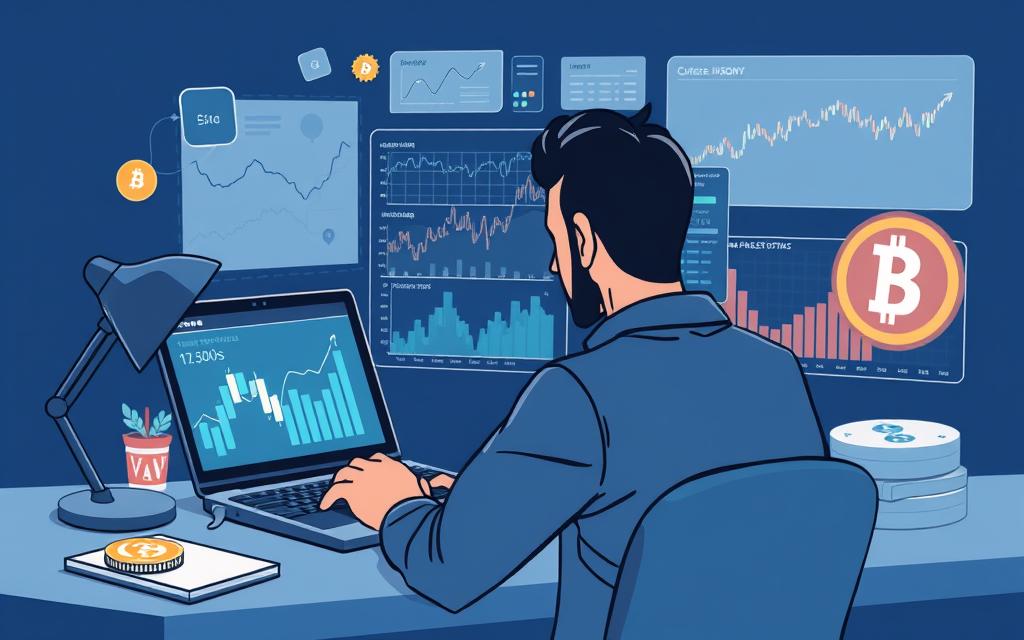Crypto Meltdown? Analyzing the Reasons Behind the Latest Crash
The cryptocurrency market has been experiencing significant turmoil, leaving investors questioning the stability of digital assets.
Recent crashes in the crypto market have sparked intense debate about the reasons behind such dramatic downturns and the factors contributing to market volatility.
Understanding the causes of these crashes is crucial for investors to make informed decisions. This article will provide a comprehensive analysis of the technological, regulatory, and economic factors that lead to cryptocurrency crashes, examining specific case studies to extract valuable lessons.
By analyzing the dynamics of the crypto market, we aim to equip investors with the knowledge needed to navigate this volatile landscape effectively.
Understanding the Crypto Market Landscape
Understanding the crypto market landscape requires a deep dive into its complex ecosystem and the various players involved. The cryptocurrency market has undergone significant transformations since its inception, driven by technological advancements, regulatory changes, and shifting investor sentiments.
The Evolution of Cryptocurrency Markets
The cryptocurrency market has evolved substantially over the years, from a niche digital currency to a global financial phenomenon. This evolution has been marked by the emergence of new cryptocurrencies, the growth of existing ones, and the development of various crypto-related services. Top crypto exchanges like Binance, Coinbase, and Kraken have played a crucial role in this growth by providing liquidity and market access.
The rise of decentralized exchanges (DEXs) has also been a significant factor, offering an alternative to traditional centralized exchanges. DEXs provide a more secure and transparent way to trade cryptocurrencies, further expanding the crypto market’s reach.
Key Players in the Crypto Ecosystem
The crypto ecosystem comprises various stakeholders, including exchanges, miners, developers, and investors. Each of these players has a distinct role in shaping the market dynamics.
- Exchanges like Binance and Kraken provide a platform for buying and selling cryptocurrencies, thereby facilitating market liquidity.
- Miners play a crucial role in validating transactions and securing the blockchain network.
- Developers and foundations are responsible for maintaining and upgrading blockchain protocols, ensuring the continued functionality and security of the network.
- Investors, including institutional investors and individual traders, drive market demand and influence price movements.
As stated by a crypto expert, “The crypto community is a critical component of the ecosystem, driving adoption and innovation through their active participation and governance.”
“The cryptocurrency market is a complex system that is influenced by a multitude of factors, including technological, economic, and regulatory elements.”
| Key Players | Roles |
|---|---|
| Exchanges | Provide liquidity and market access |
| Miners | Validate transactions and secure the blockchain |
| Developers | Maintain and upgrade blockchain protocols |
| Investors | Drive market demand and influence price movements |
It’s essential to protect your assets by engaging with reputable and trustworthy crypto exchanges, such as Binance, Bybit, or Kraken. Understanding the roles of these key players can help investors make informed decisions and navigate the complex crypto market landscape.
Why Is Crypto Crashing? The Fundamental Causes
The cryptocurrency market is subject to various factors that contribute to its volatility and occasional crashes. Delving into the causes of crypto crashes reveals a multifaceted issue influenced by both internal market dynamics and external pressures.
The Inherent Volatility of Digital Assets
Cryptocurrencies are known for their high volatility, which is a major factor in their crash propensity. The value of digital assets can fluctuate rapidly due to changes in market sentiment, regulatory announcements, and technological advancements.
The lack of liquidity in some cryptocurrencies makes them particularly susceptible to price manipulation. Market manipulation schemes, such as Pump and Dump (P&D) schemes, can artificially inflate prices and then lead to dramatic crashes when the perpetrators exit the market.

Market Manipulation and Its Impact
Market manipulation is a significant contributor to crypto crashes. Various forms of manipulation exist, including:
- Pump-and-dump schemes that artificially inflate prices before crashing.
- “Whale” manipulation, where large holders influence market prices through coordinated buying or selling.
- Wash trading, which creates false impressions of liquidity and trading volume.
- Spoofing and layering tactics used to manipulate order books on cryptocurrency exchanges.
The impact of these manipulative practices can be seen in the table below, which highlights historical cases of suspected market manipulation and their effects on crypto prices.
| Year | Event | Impact on Crypto Price |
|---|---|---|
| 2017 | Pump and Dump Schemes | Significant price drop after manipulation |
| 2018 | Whale Manipulation | Price volatility increased |
| 2020 | Wash Trading | False liquidity led to market crash |
Understanding these factors is crucial for investors to navigate the complex crypto market landscape.
Technological Factors Behind Crypto Crashes
Behind every crypto crash, there are underlying technological factors that contribute to the market’s instability. The cryptocurrency market is heavily influenced by the technological infrastructure that supports it, including blockchain protocols, smart contracts, and crypto exchanges.
Blockchain Scalability Issues
One of the significant technological challenges facing cryptocurrencies is blockchain scalability. As the adoption of cryptocurrencies grows, the demand for faster and more efficient transaction processing increases. However, many blockchain networks struggle to scale, leading to congestion, higher transaction fees, and slower processing times. This can result in a negative impact on the market, as investors become wary of the usability and efficiency of certain cryptocurrencies.
For instance, the scalability issues of Bitcoin have led to discussions about the implementation of Segregated Witness (SegWit) and the Lightning Network as potential solutions. The table below highlights some of the scalability issues faced by major blockchain networks:
| Blockchain Network | Transactions Per Second (TPS) | Scalability Solutions |
|---|---|---|
| Bitcoin | 7 | Segregated Witness (SegWit), Lightning Network |
| Ethereum | 30 | Sharding, Layer 2 scaling solutions |
Security Vulnerabilities and Exchange Hacks
The security of cryptocurrencies is another key technological factor influencing their value. While blockchain technology is inherently secure, it’s not immune to hacking, fraud, and vulnerabilities. High-profile crypto exchange hacks and wallet breaches have eroded trust in the system. Security incidents, such as the Mt. Gox and Coincheck hacks, have had significant impacts on the crypto market, leading to substantial losses for investors and a decline in market confidence.
The relationship between security incidents and market confidence is critical. Breaches not only affect the directly involved entities but also have ripple effects across the broader crypto market, contributing to uncertainty and volatility. To mitigate these risks, exchanges and protocols must implement robust security measures, including regular audits and insurance policies to protect against potential losses.
Regulatory Challenges Affecting Crypto Markets
Regulatory uncertainty is a major concern for the crypto market, with different countries adopting varying approaches to govern cryptocurrencies. This divergence in regulatory stances creates confusion and uncertainty, impacting the market’s stability and growth.
Global Regulatory Uncertainty
The lack of a unified global regulatory framework for cryptocurrencies is a significant challenge. Countries like Japan have embraced cryptocurrencies with clear regulations, while others, such as China, have imposed strict bans. This disparity affects market sentiment and investor confidence.
The global regulatory landscape is complex, with various countries at different stages of regulation development. For instance, some nations have established clear guidelines for cryptocurrency trading and mining, while others have taken a more restrictive approach.
- Examine the impact of diverse regulatory approaches on crypto market stability.
- Discuss how regulatory clarity can influence investor confidence.
| Country | Regulatory Approach | Impact on Crypto Market |
|---|---|---|
| Japan | Clear regulations for cryptocurrency trading | Positive impact on market stability |
| China | Strict bans on cryptocurrency trading and mining | Negative impact on market sentiment |
Government Crackdowns and Their Effects
Government crackdowns on cryptocurrency activities have immediate and long-term effects on the market. For example, China’s multiple crypto crackdowns have sent shockwaves through the global crypto markets, affecting market sentiment and investor confidence.
Analyzing specific government actions, such as enforcement against major exchanges or crypto businesses, reveals their significant impact on market-wide selling pressure. Additionally, anti-money laundering (AML) and know-your-customer (KYC) regulations affect market accessibility and trading volumes.

- Analyze the effects of government crackdowns on crypto market dynamics.
- Explore how AML and KYC regulations impact market accessibility.
Market Sentiment and Speculation
The crypto space is heavily influenced by how investors perceive market situations. A single tweet from a prominent figure or a news article can trigger a massive shift in sentiment, leading to significant price movements.
The Role of FOMO and FUD in Market Cycles
FOMO (Fear of Missing Out) and FUD (Fear, Uncertainty, and Doubt) are crucial elements in crypto market cycles. FOMO can drive investors to buy into a rising market, further driving up prices. Conversely, FUD can lead to panic selling, exacerbating market downturns.
Understanding and managing these sentiments is key to navigating the volatile crypto market. Investors must be aware of the potential for market manipulation through the spread of misinformation.
Social Media Influence on Crypto Prices
Social media platforms have become primary channels for crypto information and misinformation. Influential figures like Elon Musk can significantly impact crypto prices with their tweets. The “Elon Musk effect” is a notable example where his social media activity has moved markets.

Platforms like Twitter, Reddit, Discord, and Telegram play a significant role in shaping market narratives. Coordinated social media campaigns can manipulate prices, particularly for smaller cryptocurrencies. Social media sentiment analysis is being used to predict market movements and identify potential crashes.
External Economic Factors Impacting Cryptocurrencies
External economic factors play a significant role in shaping the cryptocurrency landscape. The crypto market is not isolated from global economic trends, and changes in these trends can significantly impact cryptocurrency valuations.
Global Economic Instability
Global economic instability is a critical factor that affects the crypto market. During times of economic uncertainty, investors often seek safe-haven assets, which can include cryptocurrencies like Bitcoin. This can lead to an increase in their value. The relationship between global economic instability and cryptocurrency investment is complex, with various factors influencing market dynamics.
- Economic instability can drive investors towards cryptocurrencies as a hedge.
- Global events can trigger market volatility, affecting crypto prices.
- The perception of cryptocurrencies as a safe haven can vary.

Inflation and Monetary Policy Effects
Inflation and monetary policy decisions by central banks also significantly impact the crypto market. When inflation rises, the value of fiat currencies decreases, potentially increasing the appeal of cryptocurrencies as an alternative store of value. Moreover, changes in monetary policy, such as interest rate adjustments, can influence the attractiveness of cryptocurrencies relative to traditional investments.
- High inflation can drive interest in cryptocurrencies as a hedge.
- Changes in monetary policy can affect capital flows into crypto.
- The price of cryptocurrencies can be influenced by economic indicators.
In conclusion, external economic factors, including global economic instability and changes in inflation and monetary policy, play a crucial role in shaping the crypto market. Understanding these factors is essential for investors navigating the complexities of cryptocurrency investment.
The Terra Luna Crash: A Case Study
The Terra Luna crash is a stark reminder of the unpredictability that defines the cryptocurrency landscape. The collapse of Terra’s algorithmic stablecoin, UST, and its associated token, LUNA, had far-reaching consequences for the crypto market.
The Collapse of UST and Its Ripple Effects
The collapse of UST, Terra’s algorithmic stablecoin, was triggered by a loss of confidence in the Terra ecosystem. As UST depegged from the US dollar, a death spiral ensued, causing LUNA’s value to plummet. This event highlighted the risks associated with algorithmic stablecoins and their potential impact on the broader crypto market.
The ripple effects of the Terra collapse were felt across the cryptocurrency market, with many investors losing significant amounts of money. The incident raised concerns about the stability of other algorithmic stablecoins and the potential for similar crashes in the future.

Lessons Learned from the Terra Ecosystem Failure
The Terra Luna crash provides several key lessons for the cryptocurrency industry and investors. Firstly, it highlights the importance of robust risk assessment and management practices, particularly for complex crypto ecosystems.
The Terra failure also underscores the need for improved governance models and transparency in cryptocurrency projects. By examining the governance failures that contributed to the Terra crash, future projects can be designed with better safeguards to prevent similar collapses.
| Lesson Learned | Description | Impact |
|---|---|---|
| Risk Assessment | Importance of robust risk management | High |
| Governance | Need for improved governance models | High |
| Transparency | Importance of transparency in crypto projects | Medium |
The Terra Luna crash serves as a critical case study for understanding the risks and challenges associated with cryptocurrency investments. By analyzing the lessons learned from this event, investors and industry participants can better navigate the complexities of the crypto market.
The 2022 Bitcoin Sell-Off Explained
The cryptocurrency market experienced a major downturn in 2022, with Bitcoin’s price falling sharply and defying predictions of a stable inflation hedge. This significant event left many investors wondering about the factors that triggered the dramatic decline.
From All-Time Highs to Devastating Lows
Bitcoin’s price began to fall as the Federal Reserve raised interest rates to combat high inflation, contradicting expectations that it would serve as a safe-haven asset like gold. The correlation between Bitcoin and traditional risk assets increased during this market downturn, further contributing to the decline. As a result, Bitcoin’s value dropped precipitously, raising concerns among investors about the inherent volatility of the cryptocurrency market.
The narrative around Bitcoin’s role as an inflation hedge began to change, influencing investor behavior and adding to the selling pressure. Regulatory developments and concerns also played a role in accelerating Bitcoin’s price decline. Moreover, the failures of projects like Terra Luna and FTX had a contagion effect, impacting Bitcoin’s price despite being separate projects.
Contributing Factors to Bitcoin’s Price Decline
Several factors contributed to Bitcoin’s dramatic price decline in 2022. Macroeconomic factors, particularly rising interest rates and inflation concerns, significantly impacted Bitcoin’s valuation. Institutional deleveraging accelerated the price decline, while technical factors such as broken support levels and trend lines contributed to the continued decline. Additionally, mining difficulty adjustments and miner capitulation affected market supply and price, further influencing the market psychology during the Bitcoin sell-off.
The media coverage and public perception of crypto “winters” also played a role in shaping market psychology, as the narrative around the decline influenced investor sentiment. Overall, the 2022 Bitcoin sell-off was the result of a complex interplay between macroeconomic factors, regulatory concerns, and market sentiment.
The FTX Bankruptcy and Its Market Impact
The FTX bankruptcy sent shockwaves through the cryptocurrency market, exposing deep-seated issues within the industry. As one of the largest crypto exchanges, FTX’s collapse had far-reaching consequences for investors and the broader crypto ecosystem.
Sam Bankman-Fried’s Downfall
Sam Bankman-Fried, the founder of FTX, faced intense scrutiny as the details of his exchange’s collapse came to light. Allegations of mismanagement and fraudulent activities led to a loss of investor confidence, ultimately resulting in FTX’s bankruptcy filing.
The downfall of Sam Bankman-Fried was swift and dramatic, with his once-prominent figure in the crypto space being reduced to a symbol of the industry’s risks. The incident highlighted the need for stricter oversight and regulation in the crypto market to prevent similar collapses in the future.
How FTX’s Collapse Shook Investor Confidence
The collapse of FTX triggered a contagion effect across the crypto market, with investors rushing to withdraw funds from other exchanges. This “bank run” phenomenon led to a sharp decline in cryptocurrency prices, further exacerbating the market downturn.
As the details of FTX’s internal operations came to light, investor confidence continued to erode. The incident raised concerns about the risks associated with centralized exchanges and custodial services, leading to a reevaluation of risk management strategies across the industry.
The FTX collapse also accelerated calls for stricter regulatory oversight, with lawmakers and regulators scrutinizing the crypto industry more closely. As the market continues to grapple with the aftermath of FTX’s bankruptcy, investors are left to ponder the long-term implications for the crypto space.
Crypto Exchanges During Market Downturns

The recent crypto crashes have raised questions about the reliability of various crypto exchanges during turbulent market conditions. Investors are increasingly concerned about the stability and security of these platforms as the market continues to experience significant downturns.
Top Exchanges Known for Stability
Reputable crypto exchanges such as Binance, Bybit, and Kraken have demonstrated stability during market volatility. These exchanges are known for their robust security measures, transparent operations, and reliable customer service.
Red Flags to Watch for in Crypto Platforms
When evaluating crypto exchanges, investors should be cautious of several red flags, including unusual token economics, lack of transparency about reserves or audit practices, operational issues like withdrawal delays, and regulatory evasion.
- Unusual token economics or extremely high yield offerings can signal unsustainable business models.
- Lack of transparency about reserves, insurance, or audit practices should concern users.
- Operational issues like withdrawal delays or customer service problems can indicate deeper troubles.
- Regulatory evasion or frequent changes in jurisdiction might signal compliance problems.
By being aware of these red flags, investors can better protect their assets and make informed decisions about which crypto exchanges to trust.
How Institutional Investors Respond to Crypto Crashes
As crypto markets crash, institutional investors adopt various strategies to mitigate losses and capitalize on opportunities. Their actions can significantly influence market dynamics and provide insights into market stability and future trends.
Institutional Strategies During Market Turbulence
Institutional investors typically employ a range of strategies during market turbulence, including diversification and hedging. By diversifying their portfolios, they can reduce exposure to any single asset, thereby minimizing potential losses. Hedging strategies, such as options and futures contracts, allow them to protect against further market declines.
Moreover, institutional investors often have access to advanced market analysis and research, enabling them to make informed decisions. They may also engage in active trading, taking advantage of price fluctuations to generate returns even in a crashing market.
The Growing Influence of Whales on Market Direction
Large cryptocurrency holders, or “whales,” play a significant role in shaping market direction. Their transactions can impact market prices, and their behavior is closely monitored by other investors. Whales can influence market trends through their buying and selling activities, and their actions can sometimes be misinterpreted as market manipulation.
The concentration of ownership among whales can affect market dynamics, as their decisions to buy or sell can lead to significant price movements. By tracking whale movements, market participants can gain insights into potential market shifts. For instance, a whale accumulating a particular cryptocurrency may signal an impending price increase, while a large sale could indicate a forthcoming decline.
Understanding the behavior of whales and institutional investors is crucial for navigating the complex cryptocurrency market. By analyzing their strategies and actions, investors can make more informed decisions and potentially capitalize on emerging opportunities.
Protecting Your Crypto Assets During Market Meltdowns

As the crypto market continues to experience volatility, investors must adopt strategies to safeguard their assets. The recent downturns in the cryptocurrency market have underscored the importance of protecting one’s investments.
Diversification Strategies for Crypto Portfolios
Diversifying your crypto portfolio is a key strategy for mitigating risk. By investing in a variety of cryptocurrencies, you can reduce your exposure to any one particular asset. This can help cushion the impact of a market crash on your overall investment.
The Importance of Secure Storage Solutions
Secure storage solutions are critical for protecting your cryptocurrency assets. This includes using hardware wallets, which offer robust security features, and following best practices for wallet management, such as securing your recovery seed and maintaining backups.
It’s also essential to understand the risks associated with keeping assets on crypto exchanges, including counterparty and liquidity risks. By adopting a combination of diversification and secure storage practices, you can better protect your crypto assets during market meltdowns.
Technical Analysis: Predicting the Next Crypto Crash
As the cryptocurrency market continues to evolve, understanding the technical indicators that signal a potential crash becomes increasingly crucial. Technical analysis provides valuable insights into market trends and potential downturns, helping investors make informed decisions.
Key Indicators That Signal Market Downturns
Several key indicators can signal a potential market downturn. These include:
- Bearish divergences between price and technical indicators, such as the Relative Strength Index (RSI) or Moving Average Convergence Divergence (MACD).
- Rising wedge patterns that often precede bearish breakdowns in cryptocurrency markets.
- Double tops and head and shoulders patterns that signal potential market tops.
These indicators, when combined with other forms of analysis, can provide a more comprehensive view of market conditions.
Chart Patterns to Monitor for Potential Crashes
Chart patterns play a crucial role in predicting potential crashes. Some key patterns to monitor include:
| Chart Pattern | Description | Implication |
|---|---|---|
| Double Top | A reversal pattern indicating a potential market top. | Bearish |
| Head and Shoulders | A reversal pattern signaling a potential trend reversal. | Bearish |
| Rising Wedge | A pattern often preceding a bearish breakdown. | Bearish |
By analyzing these chart patterns and combining them with other technical indicators, investors can better anticipate potential crypto crashes and adjust their strategies accordingly.
Investment Strategies for Volatile Crypto Markets

Effective investment strategies are essential for managing risk in the volatile crypto market. Investors must be prepared to adapt to changing market conditions.
Dollar-Cost Averaging in Downtrends
Dollar-cost averaging is a strategy that involves investing a fixed amount of money at regular intervals, regardless of the market’s performance. This approach helps reduce the impact of market volatility on investments. By doing so, investors can avoid making emotional decisions based on short-term market fluctuations. For more information on navigating crypto crashes, visit OSL’s Crypto Crash Guide.
When to Hold and When to Sell
Deciding when to hold or sell cryptocurrencies is crucial during market downturns. Investors should assess their investment time horizons and adjust their strategies accordingly. Establishing clear thresholds for selling can help remove emotional bias from decision-making. It’s also important to reevaluate initial investment theses in light of changing market conditions. By doing so, investors can make informed decisions about whether to hold or sell their crypto assets.
The Psychology of Surviving Crypto Market Crashes
Navigating the turbulent waters of crypto investing demands a deep understanding of one’s own psychological responses to market crashes. The crypto market’s inherent volatility can significantly impact an investor’s mental state, making it crucial to develop strategies for managing emotional responses and building mental resilience.
Managing Emotional Responses to Market Volatility
Managing emotional responses to market volatility is essential for making rational investment decisions. Investors can achieve this by:
- Setting realistic expectations about cryptocurrency volatility to prepare mentally for downturns.
- Focusing on fundamentals rather than price action during market turbulence.
- Engaging with a balanced community to gain support during difficult market periods.
By adopting these strategies, investors can mitigate the psychological impact of market fluctuations.
Building Mental Resilience for Long-term Investing
Building mental resilience is vital for long-term success in crypto investing. Key strategies include:
- Developing a clear investment philosophy and strategy before market crashes occur.
- Maintaining a long-term perspective to overcome short-term market noise and volatility.
- Continuously educating oneself to build confidence during market stress.
| Strategy | Description | Benefit |
|---|---|---|
| Clear Investment Philosophy | Define investment goals and risk tolerance | Reduces impulsive decisions |
| Long-term Perspective | Focus on long-term growth rather than short-term fluctuations | Helps ride out market volatility |
| Continuous Education | Stay updated on market trends and analysis | Builds confidence during market stress |
By implementing these strategies, crypto investors can enhance their mental resilience and navigate market crashes more effectively.
Conclusion: Navigating the Future of Cryptocurrency Markets
In the ever-evolving landscape of digital assets, grasping the dynamics of crypto crashes is essential for investors. Throughout this article, we’ve explored the multifaceted reasons behind cryptocurrency market downturns, from inherent volatility and technological issues to regulatory challenges and external economic factors.
The crypto market is influenced by a myriad of factors, including market sentiment, speculation, and global economic instability. Major case studies like the Terra Luna crash, the 2022 Bitcoin sell-off, and the FTX bankruptcy have provided valuable lessons on the importance of exchange selection and secure storage solutions in protecting assets during market meltdowns.
Technical analysis plays a critical role in identifying potential warning signs before major market corrections. By understanding key indicators and chart patterns, investors can make more informed decisions. Moreover, effective investment strategies such as diversification and dollar-cost averaging can help mitigate risks in volatile markets.
The psychological aspect of surviving crypto market crashes cannot be overstated. Managing emotional responses and building mental resilience are crucial for long-term success in the cryptocurrency space. As the market continues to evolve, it’s likely that we’ll see changes in its volatility.
In conclusion, understanding why crypto crashes occur is the first step toward developing resilience as a cryptocurrency investor. While market downturns present challenges, they also create opportunities for those who are prepared and patient. By synthesizing the insights from this article, investors can better navigate the future of cryptocurrency markets and position themselves for long-term success despite inevitable market cycles and crashes.
As we look to the future of crypto investment, it’s clear that a balanced perspective on the risks and opportunities is essential. With the right strategies and a deep understanding of the market dynamics, investors can thrive in this exciting and rapidly changing landscape.
FAQ
What are the main reasons behind the recent crypto market crash?
The recent crypto market crash can be attributed to a combination of factors, including global economic instability, regulatory uncertainty, and security vulnerabilities in various blockchain projects.
How does market manipulation affect cryptocurrency prices?
Market manipulation can significantly impact cryptocurrency prices by creating artificial demand or supply, leading to price volatility and potential losses for investors.
What role do social media and FOMO play in crypto market cycles?
Social media can amplify market sentiment, with FOMO (Fear of Missing Out) and FUD (Fear, Uncertainty, and Doubt) driving investor decisions and contributing to market fluctuations.
How can investors protect their crypto assets during market downturns?
Investors can protect their assets by employing diversification strategies, using secure storage solutions, and staying informed about market trends and potential risks.
What are some key indicators that signal potential crypto market crashes?
Investors should monitor chart patterns, market sentiment, and technological factors such as blockchain scalability issues and security vulnerabilities to anticipate potential market downturns.
How do institutional investors respond to crypto crashes?
Institutional investors often employ strategies such as dollar-cost averaging and may take a long-term view, holding or accumulating assets during market downturns.
What are some red flags to watch for in crypto exchanges and platforms?
Investors should be cautious of exchanges with poor security measures, lack of transparency, and unstable operations, as these can pose significant risks to their assets.
Can technical analysis predict the next crypto crash?
While technical analysis can provide insights into market trends, it is not a foolproof method for predicting crashes, as market volatility and unforeseen events can impact prices.















